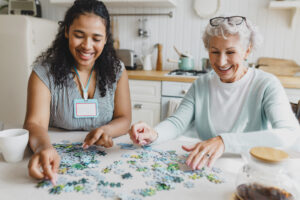Planning ahead is in many ways a product of imagination. We have to see ourselves unmoored from the present where we live our lives, and take steps to make what seems like an impossibility happen. There are, of course, a million ways that fate or chance can whirlwind our lives in any careening direction, but doing things that take imagination—like saving money, taking care of our health, and maintaining friendships—can help to make the later stages of our lives vibrant and independent.
In the same way, cities can imagine a better future for their older residents. Massive and rapid improvements in communication technology have advanced the ability of older adults to age at home, with increased dignity and a new ability to take care of themselves. And, not surprisingly, tech-heavy regions like the Bay Area are leading that transformation.
But innovation alone isn’t enough to help an aging population improve its lifestyle. Building a smart city takes imagination. It takes the foresight to create infrastructure, both technological and social, that can handle the needs of older adults. It takes the will to remember that cities aren’t just for the young, that instead they are a tapestry of all ages, interacting with the world and with their lives. In doing so, regions like the Bay Area can be more welcoming, more diverse, and more vibrant. That’s a future we should all imagine.
A Smart City for Adults Grows in Thailand
We don’t need to look too far into the future to reimagine the Bay Area, we can just glance at the present. The Saensuk municipality in Thailand’s Chon Buri province is currently best known for its graphically wild (and I do mean “graphically;” be careful opening the link) “Hell Garden” depicting the Buddhist underworld, but it’s creating a bit of heaven on earth as well. Saensuk, in cooperation with Dell Corporation and Intel Microelectronic (Thailand), is designing a smart city for seniors.
The initial project, created to improve the quality of life for Saensuk’s 40,000 older adults, will initially focus on 6000 residents. As the Bangkok Post reports, smart health sensors can digitally monitor “the patient’s walking distance and sleeping pattern, and can alert healthcare practitioners when unusual activity is detected, such as an abrupt fall or if the panic button is pressed.” Trained professionals can then be immediately dispatched.
This is a huge step up from having to physically monitor or check in on people at all times, a terrible strain on the healthcare infrastructure, and one that made older adults beholden to the schedules of their doctors and nurses. That inhibits freedom, stifles motion, and limits independence. It might sound like a paradox, but being monitored (in this case) means being more free.
So Saensuk provides a start, and a good model. But what can the Bay Area do to make this a more comprehensive approach?
How the Bay Area Can Get “Smart”
It seems antithetical to the driving spirit of the Bay Area to imagine technological limitations to the future. But those developments need to be more democratic, and shared with more people. Creating a smart city for older adults means spreading out technological gains and incorporating them into the lives of everyone, not just a few. As city planners imagine the next 10-50 years of development, here are a few things they should keep in mind:
Digital Literacy Among Older Adults
We’re happy to say that, unsurprisingly, the Bay Area is one of the nation’s leaders when it comes to improving digital literacy for older generations (a reason it’s a popular retirement spot, prices notwithstanding). Much of that comes from the older adults themselves. It’s simply not true that aging people hate technology and never want to use it—over 60% of adults over 65 have smartphones. Many just need some training, and there are citywide programs that do just that.
Of course, there are many older adults who are reluctant to learn new technology, whether out of stubbornness, fear, or the feeling that they don’t need it, but there are also many younger people who feel the same way. While no one can force someone to use technology, caregivers and professionals can be trained to teach older adults the merits of feeling comfortable with modern tech, exploring how it can improve their lives.
Cities can encourage classes by sponsoring more events and subsidizing education, both for older adults and their families. That way, the benefits aren’t limited to people already keyed in on the newest gadgets.
IoT and Telehealth
The Internet of Things, where machines communicate instantly with other machines, is on the verge of transforming every aspect of our lives, from how energy is consumed and distributed to how our cities are being built. But maybe the most transformative aspect of the IoT is what it can do for health care.
As we see in Saensuk, remote monitors can constantly track a user’s vital signs, and other aspects, such as if they’ve fallen. But it can go further than that. Ingestible tech can monitor the health of vital organs and blood, and can relay messages directly to other computers able to actually treat a patient remotely, without the patient even knowing. They can send that information to a doctor as well, if needed. Timely checkups can be eliminated, and the need for proximity to a doctor foreshortened. That allows for more independence.
This ties into telehealth, where doctors and nurses can communicate with patients through video chat services like Skype or Facetime. Telehealth can be conducted with any amount of doctors around the world. You aren’t bound by geography, which means a patient can be treated by specialists anywhere, improving the chance of recovery.
Cities can help enable this by setting up facilities where seniors without access to telescreens and other technologies at home can go, where they can take advantage of telehealth systems and the connection to medical professionals. This isn’t as ideal as having it in a person’s home, but until there is universal connection, this solves the problem of access equality.
Ride Sharing
With those telehealth facilities, though, comes the need to get people there. The Internet of Things is also revolutionizing how we drive by introducing self-driving cars which will interact with traditional vehicles and the city’s infrastructure to provide safe rides. Many think this will lead to a “post-ownership” model, where people will just hit a button and a driverless car will pick them up and take them to their destination.
This can help to solve the problem of senior dependence. If you can’t drive, you’re often beholden to someone who can, or public transportation which, depending on where one lives, can be spotty. But cities that invest in self-driving cars can help provide rides for seniors, opening up their world.
Virtual Senior Centers
But that isn’t the only way a world can be opened up. Part of aging well is meeting new people and being able to socialize. While illness and infirmity can make that hard, creating virtual senior centers where people can video chat, hang out in groups, swap music, tell stories, and show each other pictures can help to negate isolation and improve health.
While this is mostly private, cities can set up groups like Massive Open Online Courses (MOOCs): concerts or talks or demonstrations, specifically for older adults to participate in, and meet new people, and get involved. That’s one way that cities can demonstrate their willingness to make life better for everyone.
Cities age, and they change as they age. What once was a ratty, overgrown, abandoned lot is now a mixed-use multi-level. A train line becomes a bike path. Street names changes, and the shops we knew fade away, overlaid on the present through the veil of memory. But it’s still the same city, just older. It has the same bones.
It’s the same with each of us. You are the same person you were when you were younger, just in the future, which is really the endless, continuous present. Cities can make that joint present, that impossible future, better by imagining a smarter way to help older adults live the life they deserve. Getting smarter, and planning for smart cities, is the best way to make that future a reality.
Institute on Aging offers a wide range of programs, services, and online resources to help older adults live independently, with dignity and adventure. Get in touch with us today to learn more.







